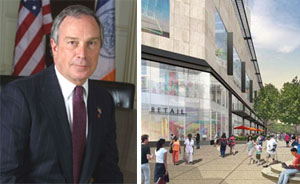
Mayor Bloomberg, a rendering of City Point
When Mayor Bloomberg first took office in 2002, he laid out a plan to incentivize developers so that New York would attract new companies in untapped neighborhoods. Nearly two terms, more than 100 rezoning measures, and $16 billion in financing for affordable housing and commercial development later, the New York Times said his development vision has been only partially successful. One reason, clearly, was the recession, which has resulted in stalled projects in places like Downtown Brooklyn, where developers of yet-to-materialize City Point project demolished a shopping mall only to leave the space vacant, so far. Others say Bloomberg’s plan was designed for and driven by developers, rather than the public good. Some areas, though, like downtown Jamaica, Queens, have seen major economic revitalization under Bloomberg’s watch. He has presided over the rezoning of one-fifth of the city, and his affordable housing program has allowed for more than 20,000 apartments for people earning less than 60 percent of the area’s median income. Construction spending has doubled since he took office, according to the New York City Building Congress. Overall, rezoning may be Bloomberg’s most significant development legacy, according to Jonathan Bowles, director of the Center for an Urban Future. Rezoned areas “are what will ultimately transform a large chunk of the city,” he said. [NYT]